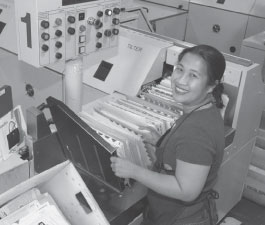 |
page 32 of 87 |  |
2. Continue Equipment, Technology, and Facility Investments
The Postal Service will continue to invest in equipment, technology, and facilities to support service and productivity improvements.
Letter Equipment
Letter distribution efficiencies have been achieved by improving read rates on existing equipment through better software, deploying equipment enhancements and scanners, and increasing the volume of letters sorted in delivery point sequence. The most recent major investments in letter automation were for the Postal Automated Redirection System (PARS), which reduces costs associated with handling mail that must be forwarded or returned to sender. Phase II of PARS will complete deployment during 2007. Scheduled investments include upgrading cancellation/postmarking equipment by 2006. Other programs will reduce piece handlings and sorting errors. These include the addition of automated "doubles detectors," which will reduce errors that result when two or more letters become stuck together in production or processing. By 2007 state-of-the-art Delivery Input/Output Subsystem (DIOSS) equipment will replace aging Multiline Optical Character Reader machines and either reduce or eliminate Mail Processing Barcode Sorters. With up to 302 separations, DIOSS sorts mail to up to three times as many separations than the machines it will replace.

Flats Equipment
Much of the successful application of automation to letters has been duplicated for flats. In 2002 the Postal Service completed deployment of the Automated Flat Sorting Machines (AFSM) 100. Featuring high-speed automated processing and online video encoding, the AFSM 100 produced dramatic improvements. Flats productivity almost doubled in processing facilities, with about 80 percent of flats now processed on the AFSM 100. New investments to enhance the equipment include automatic induction and sweeping, which began deployment in 2005. Flats sequencing technology will also be examined. Similar to letter sequencing, flats would be automatically arranged in the order of delivery for carriers. If practical and cost effective, automated flats sequencing holds great promise to reduce remaining manual mail sortation. Initial deployment could begin in 2008.